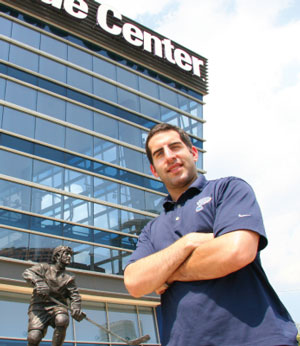 Andrew Abrams |
When most kids see their first NHL game, they follow the puck and the players’ every move. But when Andrew Abrams, a 2008 graduate with a degree in Communication—TV/Digital Film, went to his first Buffalo Sabres game, the on-ice action was cast to his periphery.
“I was a very curious kid when it came to technology,” he explains. “I was more concerned with what was going on technically around the game, like ‘Where is that camera guy sitting?’ or ‘Where are the lights positioned?’”
The Allegany, N.Y., native began honing his skills in high school at the local BOCES. At that time, he was focused on a career in video, but not necessarily in sports. That began changing while pursuing his associate’s degree at Cayuga Community College, and his focus sharpened when he transferred to Fredonia.
“Fredonia is where I learned Final Cut Pro and Adobe After Effects, the industry standard and what we use with the Blues,” he says, crediting professor Kay McDonough for helping to develop his “dramatic side” of editing, as well as Amber Rinehart, who was also a mentor.
His first job after graduating took him to Syracuse, where he worked for Time Warner creating video replays for Syracuse University lacrosse and football in addition to local high school sports. A year later, he was hired by the Manchester Monarchs, the American Hockey League affiliate of the NHL’s Los Angeles Kings. Then, in 2010, he discovered a position available with the Blues and — despite being all of 25 at the time and among dozens of candidates — he applied and was hired. Today he is the lead video editor and game night video director for the club, leading a team of up to 10 crew members on any given night.
“Making it to the NHL just tops it all,” says Abrams. “The first time I saw one of my TV commercials air, it was like a recording artist hearing his song on the radio for the first time.”
Abrams has quickly felt at home in St. Louis, a true “sports town” with loyal hockey fans. “We sold out every game this season,” he attests. “It’s surreal at times, when you realize how many people are getting to watch your stuff. I try to take a step back every now and then to appreciate everything that’s happening, but it’s really nice to have that kind of crowd
to perform for.”
“Performing” is actually how he sees it. He understands that he’s every bit a part of the game as any player, and if he doesn’t bring his best every night, fans would walk away with a lesser experience.
Plus, as he knows first-hand, there’s probably at least one fan in that crowd of nearly 20,000 each night that might actually be more interested
in his JumboTron than the game itself.



